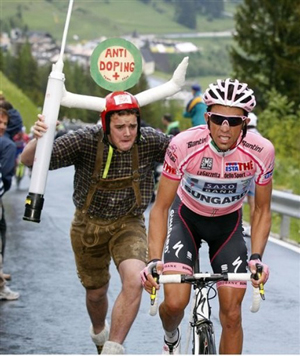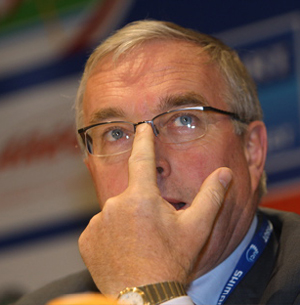Ask me if I care anymore
 Thu, May 26, 2011
Thu, May 26, 2011 What a week it has been for the sport of professional cycling. It started off with the Tyler Hamilton interview on 60 Minutes; now we hear that Alberto Contador’s Clembuterol appeal will now not be heard before the start of this year’s Tour de France.
The joint appeal by the UCI and the World Anti Doping Agency (WADA) is against the Spanish Cycling Federation’s finding that Contador is innocent of clenbuterol use. The case to be heard by the Court for Glacial Arbitration in Sport (CAS) has been delayed at the request of Contador’s lawyers. Apparently they need more time to gather evidence.
This is ridiculous, cycling fans had been promised, and it was expected to be settled one way or another before the TDF. The man I feel for is Christian Prudhomme the man who puts on the Tour de France, what does he do now, let Contador ride or not? He is screwed either way.
I am to the stage where I don’t care anymore, and I think that is exactly the tactic being played by the UCI. The UCI failed to ban Contador when he tested positive for clenbuterol, but instead turned the responsibility over to the Spanish Cycling Federation.
When Spain found Alberto innocent, the UCI has to go through the motions of an appeal. But it is a half assed appeal, one they don’t really want to win. I don’t hear any loud protests from the UCI at this latest delay, and if you remember one of the reasons this case has gone on this long is because the UCI waited until the very last minute to launch an appeal.
I predict that the whole matter may resolve itself; I think Contador will voluntarily withdraw from this year’s Tour de France. The reason; this year’s Giro d’Italia has been brutal over a route that has had an exceptional number of tough mountain stages.
After last Saturday’s stage 15. 143 miles (229 km.) featuring five big climbs over the Dolomites from Conegliano to Gardeccia Val di Fassa, Contador said it was the “hardest day of racing in his life.” (Video above.)
I don’t believe he was expecting to ride both Grand Tours. Remember he only has a month to recover before the start of the TDF. If he rides he will not be on top form, and he will have stronger opposition than he has had in the Giro. Could be interesting.
Another interesting tid-bit of news emerged today. Switzerland has more than 50 World Sports governing bodies based in its country. The UCI is just one of them. The Swiss Government is investigating corruption in those sport’s governing bodies. Good timing, I hope the UCI is up there on their list.
 Comment,
Comment,  Drugs in Sport,
Drugs in Sport,  Opinion,
Opinion,  UCI
UCI 

























Does the UCI stifle innovation?
Does the UCI prevent innovation with its regulations? The answer might surprise you.
In my last article that touched on the modern carbon fiber frame and its design, I mentioned that companies were basically sticking with the old geometry that has been around thirty or forty years.
No one seems willing to tweak the design a little, to A.) Place the rider in a more efficient riding position, and B.) Make the bike handle better when going around corners, and at extreme speeds when descending steep hills.
Thirty or more years ago all racing frames were lugged steel, built by craftsmen. There were certain restrictions on frame geometry because it was not cost effective to make lugs in a wide range of angles.
I did this with the aid of a small hammer in what I describe as, "A little refined blacksmithing."
However, I was just one builder who had taught myself certain individual skills; my methods were not practical for most larger production facilities.
Today frames are either molded from carbon fiber, or they are welded steel or aluminum; there is no restriction on what angles the various elements of the frame need to be. Within what is allowed by UCI regulations that govern competition.
When I built frames, although I didn’t necessarily follow what everyone else did; my bikes were being used in UCI sanctioned events, so I always designed and built within the UCI regulations.
I needed to check to see if the UCI had changed those restrictions since I retired. Yesterday I emailed the UCI in Switzerland asking for a copy of their frame specs, and was very surprised to get a prompt reply back this morning, in less than 24 hours.
As I suspected these are mostly the same set of rules that have been in place for years. I would hazard a guess that these haven’t altered since I first became interested in frame design in the late 1950s and early 1960s.
The only changes made recently were those pertaining to the cross-section of the frame tubes. I wrote about these in two articles, Part 1. on June 17, 2009 and Part 2. on June 19, 2009. The reasons for these changes I think I addressed fully in these previous articles.
However, there is no UCI rule that says head and seat angles have to be 73 degrees, or any other angle for that matter. No UCI rule that says a fork rake has to be 43 to 45mm. Which today seems to be the industry standard.
All the UCI does in this case is lay down maximum and minimum measurements between certain points on a frame.
Below is a drawing from UCIs regs; notice it is an old school level top tube frame because this drawing has been around for years. The various dimensions are marked with article numbers and these are described below the drawing.
1.3.012 A bicycle shall not measure more that 185 cm (72.75 in.) in length and 50 cm (19.081 in.) in width overall.
1.3.013 The peak of the saddle shall be a minimum of 5 cm to the rear of a vertical plane passing through the bottom bracket spindle. This only applies to road and cyclo-x bikes. Track bikes can be less as long as the nose of the saddle is not forward of the BB center.
1.3.014 The saddle support shall be horizontal. The length of the saddle shall be 24 cm minimum and 30 cm maximum. (Between 9.437 in. and 11.081 in.) Interestingly saddle length and BB height is the same; see below.)
1.3.015 Bottom Bracket Height, The distance between the bottom bracket spindle and the ground shall be between 24 cm minimum and maximum 30 cm. (Between 9.437 in. and 11.081 in.)
1.3.016 Front and rear centers. The distance between the vertical passing through the bottom bracket spindle and the front wheel spindle shall be between 54 cm minimum and 65 cm maximum (Between 21.25 in. and 25.562 in.)
The distance between the vertical passing through the bottom bracket spindle and the rear wheel spindle shall be between 35 cm minimum and maximum 50 cm. (Between 13.75 in. and 19.687 in.)
1.3.018 Wheels of the bicycle may vary in diameter between 70 cm maximum and 55 cm minimum, (Between 27.562 in. and 21.625 in.) including the tire.
For the cyclo-cross bicycle the width of the tyre (measured between the widest parts) shall not exceed 33 mm and it may not incorporate any form of spike or stud. (In other words, no mountain bike tires on cyclo-cross bikes.)
The reason for these UCI regulations is simple. They are there to ensure that no competitor has an aerodynamic or mechanical advantage over another; either by riding in a reclining position or making the bicycle itself aerodynamic beyond that which is allowed.
To be fair when Aero-bars became popular with triathletes in the late 1980s the UCI eventually sanctioned them for use in time-trials and certain track events. The only restriction placed on aero-bars is that the hands be no further than 75cm. (29.5 in.) maximum, from the center of the BB.
So there you have it; it is not the UCI who are stifling progress or restricting what the manufacturers can build; it is the manufacturers themselves either playing it safe, or cutting costs by limiting what is available.